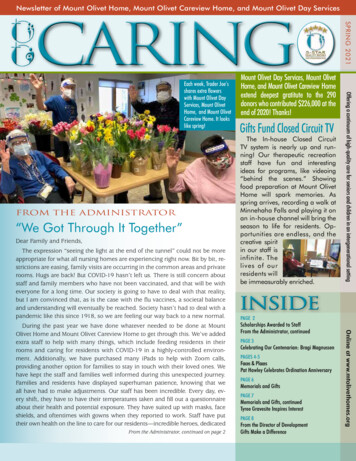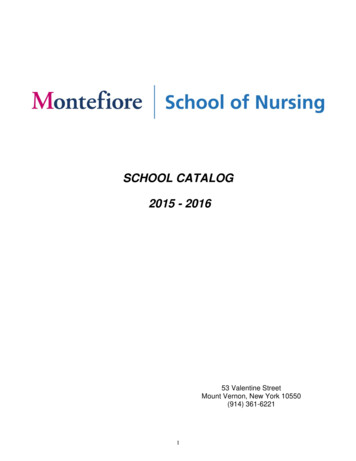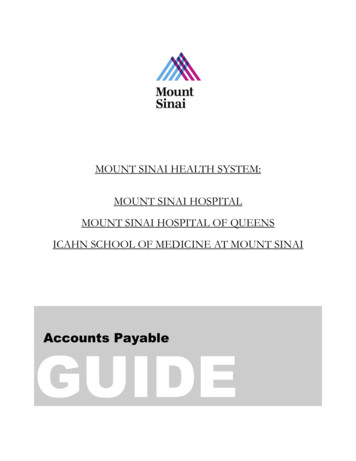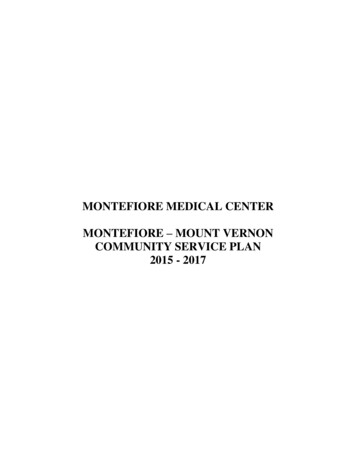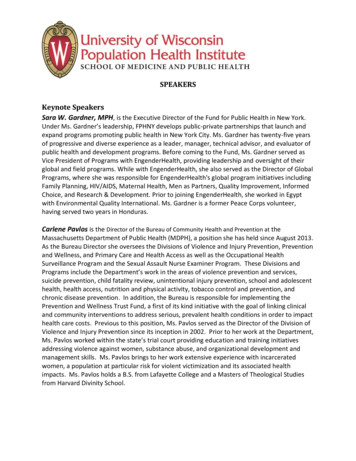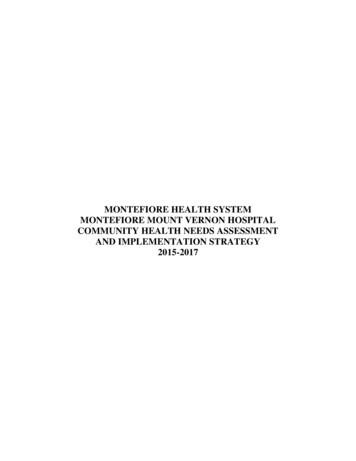
Transcription
MONTEFIORE HEALTH SYSTEMMONTEFIORE MOUNT VERNON HOSPITALCOMMUNITY HEALTH NEEDS ASSESSMENTAND IMPLEMENTATION STRATEGY2015-2017
Montefiore Health SystemMontefiore Mount Vernon HospitalCommunity Health Needs Assessment and Implementation Strategy 2015-17TABLE OF CONTENTSCOMMUNITY HEALTH NEEDS ASSESSMENT1. Introduction/This Is Montefiorea. Montefiore’s Mission and Strategyb. Date CHNA Completed2. Definition and Description of the Community/Service Areaa. The Population of Mount Vernonb. Health Disparitiesc. Medically Underserved Communities3. Assessment of Community Health Needa. Description of Process and Methodsi. Data Sourcesii. Collaborations/Partnershipsiii. Partners/Organizationsiv. Representation of medically underserved, low income orminority populationsPage333457791010111415214. Identification of Community Health Needsa. Data AnalysisIMPLEMENTATION STRATEGY5. Measures and Identified Resources to Meet Identified Needsa. Internal Resources and Measuresb. New York State Health Improvement Plan - Implementation Planand Measures2020545558986. References7. AppendicesA. Primary Data Collection Materialsi.Community Survey – English, Spanish, French Creole,Yiddish, Portugueseii.Community Survey Recruitment Flyer – English and Spanishiii. Focus Group Recruitment Flyer – Englishiv.Focus Group Discussion Guide – Englishv.Community Forum Discussion Guidevi.Community Forum Recruitment FlyerB. Montefiore Community Service Inventory1071151161681691701731741762
COMMUNITY HEALTH NEEDS ASSESSMENT1.IntroductionMontefiore Health System is a premier academic health system and the University Hospital forAlbert Einstein College of Medicine. Combining a nationally-recognized clinical excellence witha population health perspective that focuses on the health needs of communities, Montefioredelivers coordinated, compassionate, science-driven care where, when and how patients need itmost. Montefiore consists of six hospitals and an extended care facility with a total of 2,080 beds,a School of Nursing, and state-of-the-art primary and specialty care provided through a networkof more than 150 locations across the region, including the largest school health program in thenation and a home health program.The Montefiore Mount Vernon Hospital (MVH), located 12 North Seventh Avenue, MountVernon, NY 10550 is a licensed 176-bed hospital comprised of 124 medical/surgical beds, 8coronary care beds, 12 intensive care beds, 22 Psychiatry beds and 10 AIDS beds. As acommunity-based teaching hospital, MVH has been serving the medical needs of the communityand region since its founding in 1891. As of November 6, 2013, as a part of the MontefioreHealth System, a premier academic medical center and the University Hospital system for AlbertEinstein College of Medicine, Montefiore Mount Vernon Hospital continues to provide inpatient,critical care and ambulatory services. Montefiore Mount Vernon Hospital is a New York Statedesignated Stroke Center and HIV/AIDS Center, and it is home to the Beale Chronic WoundTreatment and Hyperbaric Center and the Montefiore School of Nursing.Montefiore's partnership with Einstein advances clinical and translational research to acceleratethe pace at which new discoveries become the treatments and therapies that benefit patients. Themedical center derives its inspiration for excellence from its patients and community, andcontinues to be on the frontlines of developing innovative approaches to care.2a.Montefiore’s Mission Statement and Strategy:Montefiore’s Mission Statement and Strategy:In January 2009, Montefiore Medical Center completed a comprehensive review and update ofits strategic plan. The process included the development and approval by its Board of Trusteesof revised statements of the medical center’s Mission, Vision and Values.Mission:To Heal, to Teach, to Discover and to Advance the Health of the Communities We Serve.Vision:3
To be a premier academic medical center that transforms health and enriches lives.Values:Humanity, Innovation, Teamwork, Diversity and EquityAs part of that process, Montefiore established five Strategic Goals; setting out Montefiore’scourse for the decade to come:1. Advance our partnership with the Einstein College of Medicine2. Create notable Centers of Excellence3. Build specialty care broadly4. Develop a seamless delivery system with superior access, quality, safety and patientsatisfaction5. Maximize the impact of our community serviceThe inclusion of an explicit statement affirming Community Service as part of Montefiore’sMission Statement is not new. It has always been one of the core elements of Montefiore’smission. What has changed is the explicit reference to “advancing the health of thecommunities we serve”, focusing on making a measurable difference in the health of thosepopulations and communities. This is further sharpened by the inclusion as one of the fivestrategic goals the imperative, to “maximize the impact of our community service.”In pursuing that goal, Montefiore has tasked itself:To better coordinate and focus its resources on specific high prevalence/high impactproblems affecting its community;To work internally and with community partners to identify priority health needs, and;To develop and implement more effective broad-based plans of action to address them,and to advance the health of the communities we serve.4
The rationale behind this change was the realization that we must focus our efforts, if we are tomake a real, measurable difference in the health of populations, and communities. That isessentially the same logic as underpins the state’s revised Community Service Plan process.Historically, Montefiore has earned a reputation as a leader in the region, state and nation inproviding services to its community, by developing and operating an extraordinary array ofneeded services to the poor and underserved, and to specific at-risk populations (eg. children, theelderly, the HIV-infected, the homeless and victims of domestic violence).In its updated Strategy, Montefiore included a strategic goal – “Maximize the impact of ourcommunity service” – that is focused on improving performance in this critical area. It has led tothe creation of a new institutional focus for community health improvement activities – theMontefiore Office of Community and Population Health, charged to oversee, and support and coordinate Montefiore’s diverse portfolio of community healthimprovement programs and activities, enhance Montefiore’s capacity to assess and measure the health needs of the communitiesit serves, identify, assess and select a limited number of top-priority health needs in thecommunities Montefiore serves for specific focus, and lead and coordinate Montefiore-wide efforts, and, where possible working, together andwith community partners to make a difference, to measurably improve the health of thecommunities we serve.2b.Community Health Needs Assessment Submission DateMontefiore Mount Vernon Hospital’s comprehensive Community Health Needs Assessment andImplementation Strategy Report submission was approved by the Community ServicesCommittee of the Board of Trustees on November 4, 2014. The Community Health NeedsAssessment and Implementation Report (CHNA & I) report was uploaded to the Montefiorewebsite December 2014 at the rvices/2014-CHNA1-MV-with-CSSInventory.pdf.5
III.Definition and Description of the Community/Service AreaMontefiore Mount Vernon Hospital has identified the city of Mount Vernon and its surroundingtowns and villages as its primary service area. Montefiore Mount Vernon Hospital is the onlyhospital in the City of Mount Vernon, which is the southernmost city in Westchester County.Adjacent to the Bronx, it is the most densely populated community in the County with more than70,000 citizens within its 4.2 square miles. MMVH also serves a portion of the Bronx populationthat is supported the Wakefield Campus of Montefiore Medical Center.The communities served by the MMVH are extremely diverse. The service area contains pocketsof prosperity, where health insurance coverage is more prominent, along with manyeconomically challenged neighborhoods whose residents are uninsured or underinsured. Most ofthe latter do not access healthcare routinely but rather present only in crisis through theEmergency Department.Mount Vernon is a diverse urban setting, with multiple sub-populations that evidencetremendous variation. In addition to Montefiore Mount Vernon Hospital, the community isserved by many independent providers including neighboring hospitals/systems, and a FederallyQualified Health Center, which has an overlapping service area. In this setting, the focus is onspecific health needs of specific populations, in targeted communities, working with specificpartners to address the needs of this community. The ability to apply services in a targetedfashion has been Montefiore’s historical approach to developing and operating its programs ofcommunity health, and that is the approach we have taken in developing this Community ServicePlan.6
Mount Vernon Service Area7
3a.The Population of Mount VernonAccording to the 2013 American Community Survey of the U.S. Census, Mount Vernon hasapproximately 68,000 residents within zip codes 10550, 10552, and 10553. This city is 4.4square miles; noted as the 8th largest city and 2nd most densely populated city in New York State.This city is located north of the Bronx and bordered by Pelham, Bronxville, Eastchester, andYonkers.There are approximately 26,000 households in Mount Vernon. The average household size is2.79 people. Families made up 65.6% of the households; includes both married-couple families(33.4%) and single householder families (32.2% total—3.8% male, 28.4% female). Nonfamilyhouseholds consist of 34.4% of all households in Mount Vernon; includes people living aloneand non-related people living under one household. 37.6% of households include one or morepeople under 18 years of age. 9.4% of households include one or more people 65 years of age orolder.Mount Vernon is ethnically diverse. Its population is 12.3% Hispanic, 64.7% African-American,24.7% White, 2.1% Asian, and 5.3% other. Almost one-third (34.2%) of its residents are foreignborn. Among these immigrants, more people speak only English at home than any otherlanguage. The city’s immigrant communities come from diverse corners of the globe (in order oftheir numbers): Jamaica, Brazil, Mexico, Dominican Republic, Portugal, the West Indies,Trinidad & Tobago, Italy, Barbados, & Guyana.The city has one of the highest percentages of residents living below the poverty line inWestchester County. The poverty rate is 17.1% (compared to 9.7% countywide) and the medianincome is 49,395 (compared to 84,220 countywide). 22.4% of Mount Vernon children areliving below poverty; higher than the countywide percentage of 13.3%.7.4% of Mount Vernon households are on public assistance, twice the percentages inWestchester County (2.8%) and New York State (3.5%). 70.8% of students in Mount Vernonwere eligible for reduced or free lunch during the 2010-2011 school year. The Mount Vernonunemployment rate of 11.7% is one of the highest unemployment rates in Westchester County.27.8% of Mount Vernon residents ages 25 and older have received their high school diploma orGED; higher than countywide (19.4%) and statewide (26.8%) attainment rates.3b.Health Disparities in the Mount VernonThe health status of the city of Mount Vernon was measured across the indicators of overallhealth status as well as indicators of the social, environmental, and economic determinants ofhealth. While there are areas of improvement, Mount Vernon’s rates remain significantly high,when compared to the remainder of Westchester County.8
The residents in Mount Vernon have significantly high mortality rates from heart disease, cancer,stroke, and chronic lower respiratory diseases (CLRD).Mortality Rates:According to the New York State Department of Health’s (NYSDOH) Vital Statistics of NewYork State report in 2011, Westchester County (which includes the city of Mount Vernon) has anage-adjusted mortality rate of 713.4 per 100,000; similar to the statewide rate of 753.1.According to the Community Health Rankings in 2014, Westchester County ranked as number 3out of 62 NY counties to have the lowest mortality rate in New York State. The leading cause ofdeath among Westchester County residents is due to coronary heart disease (219.7 per 100,000).Asthma & CLRD:According to the NYSDOH, 8.7% of Westchester County adults had asthma from 2008-2009;lower than the statewide percentage of 9.7%.According to CDC data, the percentage of Westchester County adults with asthma increased to14% from 2011-2012; same percentage as New York State.According to an asthma report from New York State Office of the State Comptroller, the asthmaprevalence rate among Westchester County Medicaid recipients was 86.7 per 1,000 from 20082009. The prevalence rate increased to 98.4 per 1,000 from 2012-2013; similar to the statewideprevalence rate of 98.7.The average (age-adjusted) rate of asthma emergency department visits per 10,000 from 2011was 64.2 in Westchester County. In 2012, the rate of asthma emergency department visitsincreased to 67.4 per 10,000.In 2010, the age-adjusted death rate due to chronic lower respiratory diseases among WestchesterCounty residents was 24.3 per 100,000; lower than the statewide rate of 31.1. In 2011,Westchester County ‘sdeath rate decreased to 23.4; remaining lower than the statewide rate of31.2.Heart Disease & Stroke:The coronary heart disease mortality rate per 100,000 in Westchester County was 119.5 in 2011;similar to the 2010 rate of 117.1. The coronary heart disease hospitalization rate per 10,000 inWestchester County was 35.8 in 2011; similar to the 2010 rate of 36.4.9
The cerebrovascular disease (stroke) mortality rate per 100,000 in Westchester County was 25.8in 2011; an increase from the 2010 rate of 24.0. The stroke hospitalization rate per 10,000 inWestchester County from 2009-2011 was 22.8; similar to the statewide rate of 24.9.The cardiovascular disease mortality rate per 100,000 in Westchester County was 199.2 in 2011;an increase from the 2010 rate of 195.5. The cardiovascular disease hospitalization rate per10,000 in Westchester County was 133.1; similar to the 2010 rate of 135.9.Cancer:The mortality rate of all cancer diagnoses in Westchester County was 150.5 in 2010; similar tothe statewide rate of 160.2. The type of cancer with the highest mortality rate in WestchesterCounty is lung cancer (36.9 per 100,000; lower than the statewide rate of 41.8).The incidence rate of all cancer diagnoses in Westchester County was 495.2 per 100,000 in2010; similar to the statewide rate of 482.5. The type of cancer with the highest incidence rate inWestchester County is prostate cancer (22.6 per 100,000; similar to the statewide rate of 21.3).3c.Medically Underserved CommunityThe City of Mount Vernon has been designated to have a population and geography that allows itto have the medically underserved population and to be a medically underserved area withrespect to its access to primary care services. This categorization is based on an index value thatincludes the infant mortality rate, the poverty rate, the percentage of elderly population and theprimary care physician to population ratio.Health Insurance:According to the U.S. Census Bureau, as of 2010, 17.6% of Mount Vernon adults did not havehealth insurance in 2013; higher than the countywide (14.9%) and statewide (15%) rates. Duringthe same year, 5.5% of Mount Vernon children did not have health insurance; higher than thecountywide (3.1%) rate and statewide (4%) rates.Physician Shortage:As of January 6, 2014, the New York State Education Department, through the Board of Regentsat the request of the New York State Department of Health reaffirmed the City of Mount Vernonto be an identified Physician Shortage Area in accordance with the Health Resources and10
Services Administration (HRSA) designation to be Primary Care Health Professions ShortageAreas (HPSAs).While all of Westchester County does not have that designation, Mount Vernon has maintainedthat designation for over 40 years.4.Assessment of Community Health Need4a.Description of Process and MethodsMultiple conversations and meetings were convened internally and with external partners,including a thorough review of the data, which determined the activities that would be the focusover the CHNA implementation period. In this Community Health Needs Assessment andImplementation Report, the documentation of organizations and partners documents thoseindividuals, groups and organizations with whom implementation activities were planned aredetailed in the appendices.Additionally, through the development of the New York State Community Service Plan Process,two local health priorities were identified within Westchester County on which all hospitalorganizations had agreed to participate. As the asset acquisition of Montefiore Mount VernonHospital occurred after the development and release of the Westchester County CommunityHealth Assessment and Improvement Plan and during a time of transition for the facility, itspersonnel and the community, the development of a relevant, recognized, and trusted communityinformation solicitation process was paramount to gaining the support and trust necessary tosuccessfully implement any identified health priorities to be implemented in the community.In January 2013, the Westchester Department of Health Commissioner initiated a series ofmeeting with the acute care, specialty care and federally qualified health centers in the county toform a planning team to collectively identify two local health priorities, with at least oneaddressing a health disparity in support of the New York State Health Improvement Plan.Members of the pre-existing hospital entities prior to the development of Montefiore MountVernon Hospital were present, and are still employed by MMVH to provide continuity to thisprocess. Through this process, two New York State priority areas were chosen, beyond theprocess identified in the CHNA as priorities to be addressed in improving the community’shealth . Those are: to Prevent Chronic Disease; and to Promote Healthy Women, Infants andChildren.4.a.i Data SourcesMultiple data sources were used to support the identification and selection of the priority items,which were identified, selected, and reviewed with partners. A listing and brief summary of thedata sources used to complete the secondary data analysis that were used to identify the issues ofconcern beyond experience and direct observation are listed below.i.New York State Department of Health Bronx County Indicators for Tracking PublicHealth Priority Areas11
ii.iii.iv.v.vi.vii.viii.The Statewide Planning and Research Cooperative System (SPARCS)NYS Community Health Indicator ReportsCounty Health RankingsCommunity Health Needs Assessment www.chna.orgCDC Sexually Transmitted Disease Surveillance ReportNew York State Department of Health Annual HIV/AIDS Surveillance ReportAmerican Community SurveyFor this data collection process for Mount Vernon, when City of Mount Vernon data was notavailable, a custom area estimate for Mount Vernon for the specific indicator was generatedusing population weighted allocations. These estimates are aggregates of each county which fallswithin the custom area, based on the proportion of the population from the county which alsofalls in the area. Population proportions are determined for each county using 2010 census blockcentroids. This is accomplished by dividing the summed population of the census blocks(associated with each county) which fall within the custom area by the total population of eachcounty that intersects the custom area. In this way, when a custom area contains 50% of the areaof a county, but contains 90% of its population, the figure for that county is weighted at 90% inthe custom area tabulation. This approach assumes spatial uniformity of the reported figurethroughout the county. The base geography for these calculations is the county.American Community Survey (ACS)—Developed by the U.S. Census Bureau, the ACS is an ongoing survey that collects annual data onthe major characteristics of communities throughout the U.S. The data collected is categorizedinto four categories: social, economic, demographic, and housing. Social characteristics includetopics such as education, disability status, and health insurance status. Economic characteristicsdescribe the income, employment status, and poverty level of U.S. communities. Demographiccharacteristics include age, sex, and race/ethnicity information. Housing characteristics includetopics such as occupancy and vacancy, monthly rent, and household size. Approximately 3.5million U.S households are randomly selected to participate in the ACS each year. The 2013 datais the most recent data available at the time of this report. Questionnaires, datasets, surveyresults, documentation and more detailed information are available athttps://www.census.gov/acs/www/.Community Health Needs Assessment—This project was developed by the Advancing the Movement organization and the Center forApplied Research and Environmental Systems (CARES) as a web-based toolkit designed tohospitals, state and local health departments, and other organizations seeking to better understandthe needs and assets of their communities. County-level data retrieved from institutions such asthe CDC, U.S. Census Bureau, and the Public Health Institute are formulated into customizeddata reports. The Full Health Indicators Report illustrates the health needs assessment profiles ofU.S. counties using local demographics, socioeconomic factors, physical environment data,clinical care data, health behavior factors, and health outcomes. The 2012 data is the most recentdata available at the time of this report. Detailed information on the Community Health NeedsAssessment can be found at CHNA.org.12
County Health Rankings—This project is a collaboration between the Robert Johnson Foundation and the University ofWisconsin Population Health Institute. Additional data measures used in the rankings wereprovided by surveys and databases from other organizations such as the National Center forHealth Statistics, CDC, Dartmouth Institute, U.S. Census Bureau, and U.S. Department ofAgriculture. This database generates health rankings of every U.S. county and illustrates thecorrelations between local health outcomes, health factors, and socioeconomic factors. Thecounty rankings are based on summary scores calculated from individual data measures. Theoverall Health Outcomes summary score consists of data on the county’s mortality andmorbidity. The overall Health Factors summary score consists of data on the county’s healthbehaviors, clinical care, social and economic factors, and physical environment. The 2012 data isthe most recent data available at the time of this report. Detailed information on the CountyHealth Rankings can be found at YS Community Health Indicator Reports—Reports were provided by the New York State Cancer Registry and the Behavioral Risk FactorSurveillance System (BRFSS). The NYS Cancer Registry was established in 1976 to trackstatewide data of all patients diagnosed with cancer. Data collected from this registry includeexposure risks, stages at diagnosis, treatment information, and death rates. Each time a person isdiagnosed with a tumor, the hospital(s) where that person is diagnosed and/or treated is requiredby the Public Health Law Section 2401 to report information about the person and tumor to theCancer Registry within six months of patient diagnosis. The most recent year for which data onnew cases and cancer deaths are available is 2011. Detailed information on the NYS CancerRegistry can be found at y/. The BehavioralRisk Factor Surveillance System (BRFSS) is an annual statewide telephone surveillance systemdesigned by the Centers for Disease Control and Prevention (CDC). BRFSS monitors modifiablerisk behaviors and other factors contributing to the leading causes of morbidity and mortality inthe population. New York State's BRFSS sample represents the non-institutionalized adulthousehold population, aged 18 years and older. The survey is conducted in all 50 states and U.S.territories. New York State has participated annually since 1985. Statewide representativesamples are collected monthly and aggregated into yearly datasets. The 2011 data is the latestWestchester County-specific BRFSS data illustrated by the NYSDOH. Questionnaires, datasets,survey results, documentation and much more are all available at http://www.cdc.gov/brfss/.New York State Department of Health’s (NYSDOH) Westchester County Indicators forTracking Public Health Priority Areas 2013-2017—Findings are provided by various agencies such as the U.S. Census Bureau, the Center forDisease Control & Prevention (CDC), and NYSDOH programs. Detailed information providedby these agencies describe each U.S. community’s entire population, including cross-tabulationsof age, sex, households, families, relationship to householder, housing units, and race/ethnicgroups. This NYSDOH report also includes statewide & county-specific data and the 201713
targets for numerous indicators for the five major prevention agenda areas: preventing chronicdiseases; promote a healthy and safe environment; promoting healthy women, infants andchildren; promote mental health and prevent substance abuse; and, prevent HIV/STDs, vaccinepreventable disease and health care-associated infections. The 2012 data is the most recent dataavailable at the time of this report. Detailed information on the NYSDOH Public Health PriorityAreas report can be found at http://www.health.ny.gov/prevention/prevention agenda/20132017/about.htm.The Statewide Planning and Research Cooperative System (SPARCS)—This comprehensive database was established in 1979 as a result of cooperation between thehealth care industry and government. SPARCS collects patient level data on hospital discharges,patient characteristics, diagnoses and treatments, and health care services. This database systemalso collects data on charges for every hospital discharge, ambulatory surgery patient, andemergency department admission in New York State. This database features the World HealthOrganization’s Ninth Revision of the International Classification of Diseases (ICD-9), an officialset of codes used by physicians, hospitals, and allied health workers to indicate diagnosis for allpatient encounters. The 2013 data is the most recent data available at the time of this report. TheU.S. Centers for Medicare & Medicaid’s DRG (Diagnosis-Related Groups) coding system is alsofeatured in the SPARCS data. DRGs group patients by diagnosis, treatment, age, and othercharacteristics. Hospitals are paid a set fee for treating patients in a single DRG category.Detailed information on the SPARCS data can be found chester County Community Health Assessment & Improvement Plan 2014-2017—The Westchester County Department of Health (WCDOH) plays a leading role in promotinghealth, preventing disease, and prolonging meaningful life for Westchester County residents.WCDH monitors and controls the spread of communicable diseases, monitors and regulates airand water quality, enforces the state and local sanitary code, promotes local public healthactivities, and assures the availability of community health services. CDH has collaborated withlocal hospitals and other community health partners to complete a Community HealthAssessment (CHA), which describes the current health status of Westchester County residents,identifies existing gaps and health care barriers, assesses the availability and accessibility ofhealth care services, and specifies public health priorities in the County. In addition, aCommunity Health Improvement Plan (CHIP) has been crafted to lay out the specific objectives,goals, and actions of the Health Department to address the public health priorities identified inthe Community Health Assessment. Detailed information on this report can be found ii Collaboration and ParticipantsAs the Community Health Needs Assessment was being developed, two simultaneous processeswere evolving. First, Montefiore was charged with the development of its New York StateCommunity Service Plan submission for the period of 2015-2017 for the New York State HealthDepartment’s Prevention Agenda. For this process, priorities were identified within Westchester14
County on which all hospital organizations had agreed to participate. As the asset acquisition ofMontefiore Mount Vernon Hospital occurred after the development and release of theWestchester County Community Health Assessment and Improvement Plan and during a time oftransition for the facility, its personnel and the community, the development of a relevant,recognized, and trusted community information solicitation process was paramount to gainingthe support and trust necessary to successfully implement any identified health priorities to beimplemented in the community.In January 2013, the Westchester Department of Health Commissioner initiated a series ofmeeting with the acute care, specialty care and federally qualified health centers in the county toform a planning team to collectively identify two local health priorities, with at least oneaddressing a health disparity in support of the New York State Health Improvement Plan.Members of the pre-existing hospital entities prior to the development of Montefiore MountVernon Hospital were present, and are still employed by
Vernon, NY 10550 is a licensed 176-bed hospital comprised of 124 medical/surgical beds, 8 . Adjacent to the Bronx, it is the most densely populated community in the County with more than . GED; higher than countywide (19.4%) and statewide (26.8%) attainment rates. 3b. Health Disparities in the Mount Vernon
